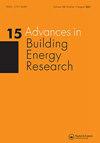Sensitivity analysis of proposed natural ventilation IEQ designs for archetypal open-plan office layouts in a temperate climate
IF 2.5
Q2 CONSTRUCTION & BUILDING TECHNOLOGY
引用次数: 3
Abstract
ABSTRACT Designing naturally ventilated deep, open-plan offices could improve occupants’ thermal comfort and productivity and ensure energy reductions; however, this can be challenging when relying on façade only openings. This research examines the ventilation performance sensitivity of atria, innovative façade openings and interior layouts of open-plan offices, in order to identify optimal typologies. Different building typologies are developed through a combination of various atria designs and configurations, with the effective use of high-aspect-ratio (HAR) openings with a similar dimension to that of the floor-to-ceiling height, in either a mid-level vertical (MLV) or high-level horizontal (HLH) orientation. Steady-state computational fluid dynamics (CFD) simulations are performed to predict internal airflow and temperature distribution in a moderate climate and water-bath modelling (WBM) experiments to validate the computational models. Results showed that MLV provide superior cooling potential (up to 2.5°C reductions) and higher ventilations rates; despite, increasing thermal gradients. Unobstructed atria with a horizontal profile similar to that of the building footprint also performed well. Overall, façade opening design was shown to be the most influential design parameter. This research has presented guidance based on reliable results to better equip building designers and architects in the design of successful naturally ventilated deep, open-plan offices.温带气候下开放式办公室自然通风设计的敏感性分析
设计自然通风的深层开放式办公室可以提高居住者的热舒适度和工作效率,并确保节能;然而,当只依赖于正面开口时,这可能是具有挑战性的。本研究考察了中庭、创新立面开口和开放式办公室内部布局的通风性能敏感性,以确定最佳类型。不同的建筑类型通过各种中庭设计和配置的组合而发展,有效地利用高纵横比(HAR)开口,其尺寸与地板到天花板的高度相似,无论是在中层垂直(MLV)还是高层水平(HLH)方向。通过稳态计算流体力学(CFD)模拟预测了中等气候条件下的内部气流和温度分布,并通过水浴模拟(WBM)实验验证了计算模型的有效性。结果表明,MLV提供了优越的冷却潜力(高达2.5°C的降低)和更高的通风率;尽管,增加热梯度。与建筑足迹相似的水平轮廓的无阻碍中庭也表现良好。总体而言,正面开口设计是影响最大的设计参数。这项研究提供了基于可靠结果的指导,以更好地帮助建筑设计师和建筑师设计成功的自然通风的深层开放式办公室。
本文章由计算机程序翻译,如有差异,请以英文原文为准。
求助全文
约1分钟内获得全文
求助全文
来源期刊

Advances in Building Energy Research
CONSTRUCTION & BUILDING TECHNOLOGY-
CiteScore
4.80
自引率
5.00%
发文量
11
 求助内容:
求助内容: 应助结果提醒方式:
应助结果提醒方式:


